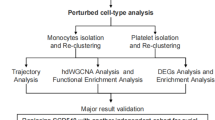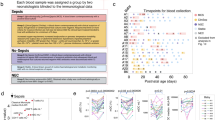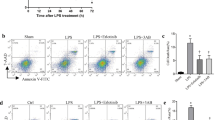Abstract
Defining critical points of modulation across heterogeneous clinical syndromes may provide insight into new therapeutic approaches. Coagulation initiated by the cytokine-receptor family member known as tissue factor is a hallmark of systemic inflammatory response syndromes in bacterial sepsis and viral haemorrhagic fevers1,2, and anticoagulants can be effective in severe sepsis with disseminated intravascular coagulation3. The precise mechanism coupling coagulation and inflammation remains unresolved4,5,6,7. Here we show that protease-activated receptor 1 (PAR1) signalling sustains a lethal inflammatory response that can be interrupted by inhibition of either thrombin or PAR1 signalling. The sphingosine 1-phosphate (S1P) axis is a downstream component of PAR1 signalling, and by combining chemical and genetic probes for S1P receptor 3 (S1P3) we show a critical role for dendritic cell PAR1–S1P3 cross-talk in regulating amplification of inflammation in sepsis syndrome. Conversely, dendritic cells sustain escalated systemic coagulation and are the primary hub at which coagulation and inflammation intersect within the lymphatic compartment. Loss of dendritic cell PAR1–S1P3 signalling sequesters dendritic cells and inflammation into draining lymph nodes, and attenuates dissemination of interleukin-1β to the lungs. Thus, activation of dendritic cells by coagulation in the lymphatics emerges as a previously unknown mechanism that promotes systemic inflammation and lethality in decompensated innate immune responses.
This is a preview of subscription content, access via your institution
Access options
Subscribe to this journal
Receive 51 print issues and online access
$199.00 per year
only $3.90 per issue
Buy this article
- Purchase on SpringerLink
- Instant access to full article PDF
Prices may be subject to local taxes which are calculated during checkout




Similar content being viewed by others
References
Esmon, C. T. Interactions between the innate immune and blood coagulation systems. Trends Immunol. 25, 536–542 (2004)
Ruf, W. Emerging roles of tissue factor in viral hemorrhagic fever. Trends Immunol. 25, 461–464 (2004)
Opal, S. M. The nexus between systemic inflammation and disordered coagulation in sepsis. J. Endotoxin Res. 10, 125–129 (2004)
Aird, W. C. The role of the endothelium in severe sepsis and multiple organ dysfunction syndrome. Blood 101, 3765–3777 (2003)
Taylor, F. B. Staging of the pathophysiologic responses of the primate microvasculature to Escherichia coli and endotoxin: examination of the elements of the compensated response and their links to the corresponding uncompensated lethal variants. Crit. Care Med. 29, S78–S89 (2001)
Pawlinski, R. et al. Role of tissue factor and protease activated receptors in a mouse model of endotoxemia. Blood 103, 1342–1347 (2003)
Camerer, E. et al. Roles of protease-activated receptors in a mouse model of endotoxemia. Blood 107, 3912–3921 (2006)
Xu, H., Ploplis, V. A. & Castellino, F. J. A coagulation factor VII deficiency protects against acute inflammatory responses in mice. J. Pathol. 210, 488–496 (2006)
Ahamed, J. et al. Regulation of macrophage procoagulant responses by the tissue factor cytoplasmic domain in endotoxemia. Blood 109, 5251–5259 (2007)
Rosen, H. & Goetzl, E. J. Sphingosine 1-phosphate and its receptors: an autocrine and paracrine network. Nature Rev. Immunol. 5, 560–570 (2005)
Feistritzer, C. & Riewald, M. Endothelial barrier protection by activated protein C through PAR1-dependent sphingosine 1-phosphate receptor-1 crossactivation. Blood 105, 3178–3184 (2005)
Singleton, P. A. et al. Attenuation of vascular permeability by methylnaltrexone: role of mOP-R and S1P3 transactivation. Am. J. Respir. Cell Mol. Biol. 37, 222–231 (2007)
Shortman, K. & Naik, S. H. Steady-state and inflammatory dendritic-cell development. Nature Rev. Immunol. 7, 19–30 (2007)
Steinman, R. M. & Banchereau, J. Taking dendritic cells into medicine. Nature 449, 419–426 (2007)
Randolph, G. J., Angeli, V. & Swartz, M. A. Dendritic-cell trafficking to lymph nodes through lymphatic vessels. Nature Rev. Immunol. 5, 617–628 (2005)
Czeloth, N. et al. Sphingosine-1-phosphate mediates migration of mature dendritic cells. J. Immunol. 175, 2960–2967 (2005)
Maeda, Y. et al. Migration of CD4 T cells and dendritic cells toward sphingosine 1-phosphate (S1P) is mediated by different receptor subtypes: S1P regulates the functions of murine mature dendritic cells via S1P receptor type 3. J. Immunol. 178, 3437–3446 (2007)
Ferrari, D. et al. The P2X7 receptor: a key player in IL-1 processing and release. J. Immunol. 176, 3877–3883 (2006)
Baroni, M. et al. Stimulation of P2 (P2X7) receptors in human dendritic cells induces the release of tissue factor-bearing microparticles. FASEB J. 21, 1926–1933 (2007)
Efron, P. A. et al. Characterization of the systemic loss of dendritic cells in murine lymph nodes during polymicrobial sepsis. J. Immunol. 173, 3035–3043 (2004)
Scumpia, P. O. et al. CD11c+ dendritic cells are required for survival in murine polymicrobial sepsis. J. Immunol. 175, 3282–3286 (2005)
Fujita, S. et al. Regulatory dendritic cells act as regulators of acute lethal systemic inflammatory response. Blood 107, 3656–3664 (2006)
Ohteki, T. et al. Essential roles of DC-derived IL-15 as a mediator of inflammatory responses in vivo . J. Exp. Med. 203, 2329–2338 (2006)
Damiano, B. P. et al. Cardiovascular responses mediated by protease-activated receptor- 2 (PAR-2) and thrombin receptor (PAR-1) are distinguished in mice deficient in PAR-2 or PAR-1. J. Pharmacol. Exp. Ther. 288, 671–678 (1999)
Ishii, I. et al. Selective loss of sphingosine 1-phosphate signaling with no obvious phenotypic abnormality in mice lacking its G protein-coupled receptor, LP(B3)/EDG-3. J. Biol. Chem. 276, 33697–33704 (2001)
Allende, M. L. et al. Mice deficient in sphingosine kinase 1 are rendered lymphopenic by FTY720. J. Biol. Chem. 279, 52487–52492 (2004)
Labasi, J. M. et al. Absence of the P2X7 receptor alters leukocyte function and attenuates an inflammatory response. J. Immunol. 168, 6436–6445 (2002)
Don, A. S. et al. Essential requirement for sphingosine kinase 2 in a sphingolipid apoptosis pathway activated by FTY720 analogues. J. Biol. Chem. 282, 15833–15842 (2007)
Pan, S. et al. A monoselective sphingosine-1-phosphate receptor-1 agonist prevents allograft rejection in a stringent rat heart transplantation model. Chem. Biol. 13, 1227–1234 (2006)
Lutz, M. B. et al. An advanced culture method for generating large quantities of highly pure dendritic cells from mouse bone marrow. J. Immunol. Methods 223, 77–92 (1999)
Acknowledgements
This study was supported by NIH grants to W.R. and H.R. and a stipend to F.N. from the Deutsche Forschungsgemeinschaft. The SphK1-/- strain was kindly provided to H.R. by R. Prioa. We thank C. Biazak, J. Royce, P. Tejada and N. Pham-Mitchell for expert technical assistance, and C. Johnson for illustrations.
Author information
Authors and Affiliations
Corresponding author
Supplementary information
Supplementary Figures
The file contains Supplementary Figures 1-6 with Legends and additional references. (PDF 794 kb)
Rights and permissions
About this article
Cite this article
Niessen, F., Schaffner, F., Furlan-Freguia, C. et al. Dendritic cell PAR1–S1P3 signalling couples coagulation and inflammation. Nature 452, 654–658 (2008). https://doi.org/10.1038/nature06663
Received:
Accepted:
Published:
Issue date:
DOI: https://doi.org/10.1038/nature06663
This article is cited by
-
Fingolimod Modulates the Gene Expression of Proteins Engaged in Inflammation and Amyloid-Beta Metabolism and Improves Exploratory and Anxiety-Like Behavior in Obese Mice
Neurotherapeutics (2023)
-
Sphk2 deletion is involved in structural abnormalities and Th17 response but does not aggravate colon inflammation induced by sub-chronic stress
Scientific Reports (2022)
-
Identification of S1PR3 gene signature involved in survival of sepsis patients
BMC Medical Genomics (2021)
-
Critical roles of sphingosine kinase 1 in the regulation of neuroinflammation and neuronal injury after spinal cord injury
Journal of Neuroinflammation (2021)
-
Atherosklerose: Verlust des Sphingosin-1-phosphat-Rezeptors 3 im Menschen
Gefässchirurgie (2021)



